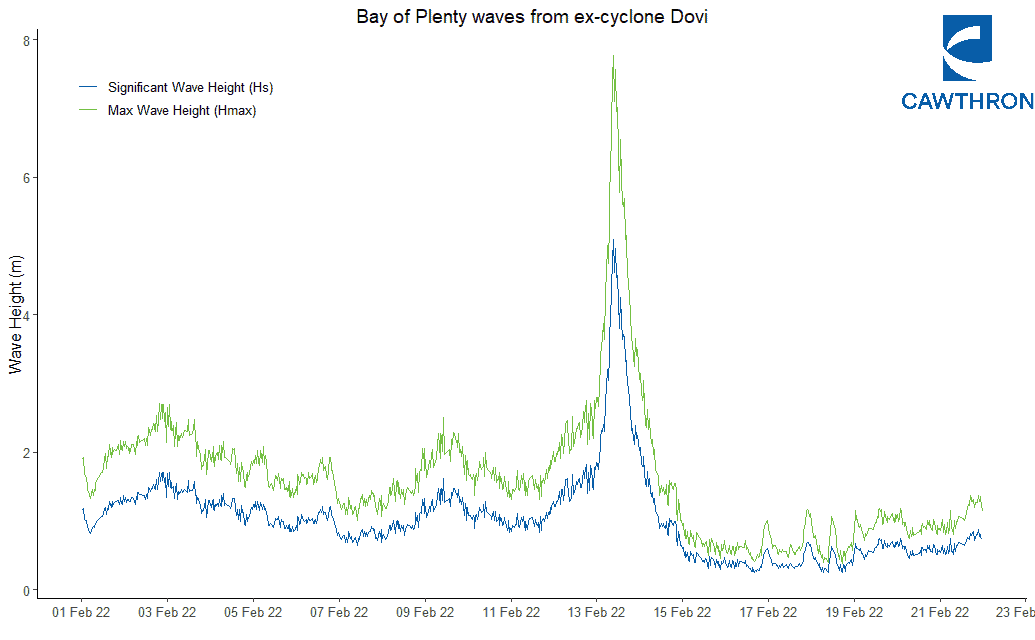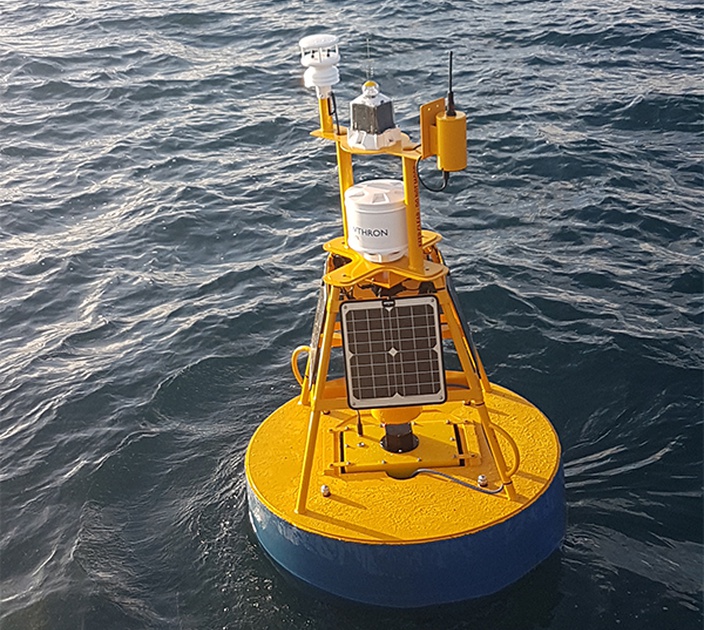Cawthron’s Kūtai buoy records 8m swells during ex-cyclone Dovi
28 February 2022
A Cawthron Institute coastal monitoring buoy Kūtai recorded ‘nasty’ 8m swells off the coast of Ōpōtiki during ex-cyclone Dovi’s charge across New Zealand in mid-February.
The buoy, which is the only one of its kind in the Bay of Plenty, withstood the challenging swells to collect data on wave height and other conditions and feed it back to land where it is accessible via Cawthron Institute’s website.
The green line on the graph shows the size of the largest waves recorded, which were over 8m, and the blue line shows the significant wave height. Senior marine scientist and R&D engineering team leader Paul Barter says ‘significant wave height’ is a technical term that helps us put these measurements into context.

“We take all the data we have on wave height over a twenty minute period, and ‘significant wave height’ is the highest one-third of those waves.”
Barter says since the Kūtai buoy was deployed in July 2018, significant wave heights in excess of 2.5 metres have been uncommon and there have only been two other instances where they have exceeded 4 metres in height.
“The ex-cyclone Dovi event represents the first time significant waves have been measured by the buoy greater than 5 metres high, so it’s clear that this was a significant storm event and recreational boaties out there might have found themselves in trouble.”
Barter says the data that the buoy recorded demonstrates the progress Cawthron is making towards enabling the widespread remote monitoring and management of marine farms.
“Cawthron is one of New Zealand’s leading developers of new coastal monitoring technologies, and we have several programmes of work dedicated to this subject including our MBIE-funded Open Ocean Aquaculture research programme and our Precision Farming Technologies for Aquaculture Project funded through the Science for Technological Innovation National Science Challenge.”
“One of the keys to success in enabling the remote monitoring of marine farms is to produce technology that can withstand the high energy environment you’re deploying it into, and we’re really pleased to see Kūtai was up to the task,” Paul Barter says.
“I often jokingly tell people that ‘the ocean likes to eat things’ because it really does! We spend a lot of time and effort trying to build technology that gets past that challenge.”
Cawthron Institute R&D Engineering Team Leader, Paul Barter.

Cawthron Institute’s Kūtai coastal monitoring buoy.
The Kūtai buoy is located on the Whakatōhea Mussels marine farm off Ōpōtiki in the Bay of Plenty. The buoy was designed and built by Cawthron as part of an MBIE funded research project called ‘Enabling Open Ocean Aquaculture,’ led by Cawthron.
Kūtai, and the other buoys in Cawthron’s coastal monitoring network, record parameters including waves, water currents, wind speed and direction, water temperature and biologically important measures like dissolved oxygen and chlorophyll-a.
“We’re working to develop a range of reliable and affordable sensors and solutions so we can provide marine farmers with the data they need, in real-time, to make decisions about how to manage their farm from the comfort of their desk.”
